For the efficient operation of the ventilation network, it is necessary to adjust the volume and speed of the air masses passing through it. For this purpose, a special device is mounted on the chimney - a gate valve for ventilation.
Concept description
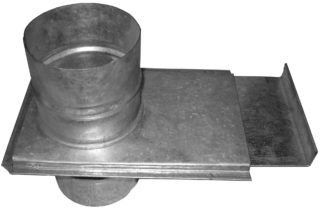
The ventilation gate is used to restrict or completely block the passage of the air flow. The device is shaped like a valve. Parts of similar design are used in hoods, water drainage systems. The dampers are used for air ducts made of any material, including polypropylene and plastic in general. Since fire safety rules prescribe to make a chimney of refractory material (brick or steel), you need to use a metal damper for it.
The mechanism of work of the part is identical to that of the usual valve used to control the draft in the pipe. When the fuel is ignited, an open damper activates the movement of air currents. While the wood or peat is burning through, the part is left only slightly open to prevent smoldering too quickly. When the process is completely finished, you can close the passage. The ventilation gate operates in a similar way: it activates, then blocks the air flow. An element can control flows from the master node to the outgoing branches.
Gate classification
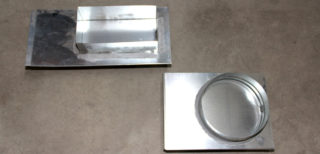
The classification of ventilation valves can be carried out on several grounds. They differ in shape, design, method of installation on the chimney, methods of control of work.
By form
The section of the airway can be circular or rectangular. Accordingly, a part for installation is selected. According to statistics, a gate for a round duct is used very rarely. It can only be mounted on an appropriately shaped tube. Rectangular dampers for ventilation are more common.
There are situations when a round ventilation gate cannot be installed, only the installation of rectangular parts is permissible. This includes systems with electric heaters, as well as cases when the valve needs to be hidden, and there is little free space.
By design
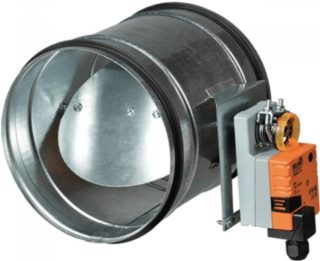
The most popular and reliable designs are retractable. They are widely used in tin and brick chimneys. This type of device provides:
- passage of air masses with a minimum of losses;
- the greatest tightness;
- simplicity of the chimney cleaning procedure.
There are rotary models. They are not highly reliable - the moving component of the mechanism easily breaks down. They are used when design or technical features do not allow mounting a retractable product. There is a twig in the middle of the device. A sheet of metal is attached to it, rotating around its axis.
By type of control
In addition to traditional manual products, there are automatic gates as well as hydraulically and pneumatically controlled devices. The motorized ventilation damper opens and closes by pressing a button (usually a remote control).
By material of manufacture
Chimney dampers are made of various types of steel sheets. The material can be chrome-plated, alloyed or anti-corrosive. Parts designed for installations that do not involve high temperatures can also be made of other materials, for example, plastics.
Installation features and installation methods
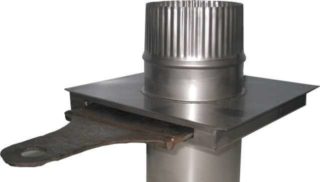
The most common type of mounting is placing the unit in front of the fan outlet. When their location is identical, the mounted gate is called the starting gate. This part protects the power plant from excessive heating.
The ventilation device is started only when the damper is in the closed position. Otherwise, the fan will be overloaded. If this rule is regularly disregarded, the equipment will become unusable.
Some products are designed to be installed directly into the chimney. Others are supposed to be mounted using fixing fasteners. This includes the flanged method.
Wafer connection
The easiest method to carry out is to install a valve directly into the chimney pipe. This type of part placement is attractive in that it involves the use of additional parts for fastening the mechanism. However, not all types of dampers are designed for installation in this way.
Another method is to install a valve in front of the chimney outlet or in the furnace itself. In this case, the part becomes a component of the heating structure. However, there is a height limitation. The damper to be installed must be at a height of no more than 1 m.
Flange connection
When fastening the valve using a flange, certain installation norms must be taken into account. The parts fixing the chimney must be located at a certain distance from the damper itself. It is prohibited to mount them together with the gate. Also, fasteners must be placed strictly on a specific side of the flange. This connection requires an additional seal.
How to make a gate for ventilation with your own hands
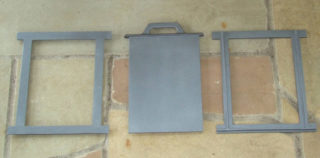
It is quite simple to make a do-it-yourself ventilation gate equipped with a retractable plate. First, you need to find out the dimensions of the chimney section using a construction tape. Based on them, a simple drawing is prepared.
The most affordable materials for a home damper are galvanized sheet metal and stainless steel. You need to prepare 2 sheets of one of these metals. A thickness of 0.7 mm is suitable. A frame is placed between the sheets, the parameters of which depend on the dimensions of the chimney. Bends are made around the perimeter of the flap. A hole is cut in the center to combine the two nozzles. For fastening, a heat-resistant hermetic composition is used. A plate is inserted between the layers to overlap the traction.
Using a chimney damper allows you to control the draft level. You can buy ready-made gates in a shell made of carbon steel sheets or make a part at home.








